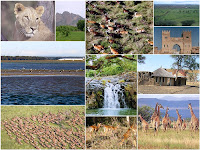Safari Notes: Kisumu's Moment

Nakuru, has since the death of the Late President Jomo Kenyatta, which the city was a favorite retreat for, degraded; and so has Mbale in Uganda, which too, has degraded and decayed since the early seventies. And, Kisumu has since the late seventies continued to degrade, decay and become a sleepy, slumbering place with pot-holed streets and roads, and with a collapsing economy, an inefficient infrasrtucture and failing municipal services. Only Arusha, in Tanzania, has continued to develop, improve and shine.
About 320 kms. (200 miles) North-west of Nairobi. With a population of about 800,000. The capital of Nyanza Province. Only 25 kms. (15 miles) or so from the Equator and about 1,500 meters (5,000 feet) above sea level. With a moderate temperature. Situated on the shores of Lake Victoria, the World's second largest, fresh water body; hot, humid Kisumu - was once a vibrant, very pleasant city and for decades, it was the hub of transport activity between the Coast and Uganda and Western Tanzania. The city has a large Indian population, who control its economy and business activities almost completely.
For years now, Kisumu has been crumbling and decaying; and has become a sleepy, slumbering city with its many streets and roads, pot-holed; and garbage and sewage becoming a big problem. Electricity and piped, fresh water supply are inefficient and not enough to co-op with the city's large, rapidly growing population. Traffic is congested and can be very annoying. Once, a town almost free of violent crime, Kisumu, now, is far from that. Many of its affluent citizens have fled, especially since the last elections violence; most of those fleeing are the Indians, who have been the main backbone of the city's economy. Worse, of all Kenyan large urban centers, Kisumu has been the most ravaged by malaria and HIV/Aids.
Still, all is not gloomy for Kisumu. It's slowly rising and trying to regain its old sparkle and vibrancy. It has been declared by the UN as the first Millennium City in the 2015 Millennium Development Program and as a result, is poised to become a model for economic reform on the African continent. The area has immense resources and is in a strategic location to be a center of commerce and diplomacy in the East and Central African region. As a Millennium City, Kisumu will be working towards achieving the Millennium Development Goals by 2015 which include eradicating poverty and extreme hunger, achieving universal primary education, promoting gender equality, reducing child mortality, improving maternal health, and combating HIV/AIDS, malaria, and other diseases. I believe, Kisumu will again become what it once was and much more; with the Luos at their most successful now, this is Kisumu's moment.
Photo: Victor O


